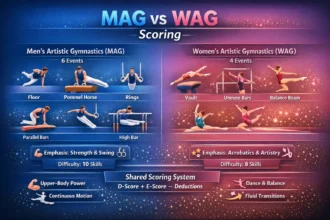Gymnastics deductions are often small, but they add up quickly. This guide explains how gymnastics deductions work, what judges watch for on each event, and how penalties are applied at different levels of competition.
How Scores Are Built (Quick Refresher)
In artistic gymnastics, every routine is evaluated by two separate judging panels: one calculates difficulty (D-score) and the other evaluates execution (E-score).
The gymnast’s final score is calculated using this formula:
Final Score = D-Score + E-Score − Neutral Deductions
For a full explanation of how difficulty, execution, and penalties combine into a final score, see our guide to how gymnastics scores are calculated.
Judging Panels & Execution Deductions
Execution deductions are applied by the E-panel, which evaluates how cleanly, safely, and artistically a routine is performed.
Under the FIG WAG 2025–2028 Code of Points, execution faults follow a standardized deduction scale across apparatuses.
Execution Fault Scale (2026)
| Fault Severity | Typical Deduction | Examples |
|---|---|---|
| Small fault | 0.10 | Minor balance check, slight form break |
| Medium fault | 0.30 | Bent arms, leg separation, noticeable wobble |
| Large fault | 0.50+ | Large hop, deep squat, major balance error |
Multiple faults may be deducted within a single element, subject to event-specific caps.
Falls
A fall is one of the most significant deductions in gymnastics and always affects the E-score.
Fall Deductions by Competition Type (2026)
| Competition Type | Fall Deduction |
|---|---|
| FIG WAG (2025–28) | −1.00 E-deduction |
| NCAA (2024–26) | −0.50 E-deduction |
| USAG DP (2022–26) | −0.50 E-deduction |
In FIG WAG, a fall incurs a −1.00 execution deduction. Difficulty credit is affected only if the element fails to meet recognition requirements or a required connection is broken.
In NCAA and USAG DP, falls are penalized at −0.50 execution, and routines do not lose difficulty credit due to the absence of open-ended D-scores.
Universal Execution Deductions (Apply to All Apparatus)
1. Form and Technique Deductions
| Fault | Typical Deduction |
|---|---|
| Feet/Toes not pointed, flexed, or sickled | 0.10 |
| Leg or knee separation | 0.10–0.20 |
| Bent arms or legs | 0.20–0.30 |
| Insufficient split in leaps or jumps | 0.10–0.20 |
| Posture or shape errors (arching, piking) | 0.10–0.30 |
| Incomplete turns or poor axis | 0.10–0.20 |
| Artistry or choreography faults (FX) | 0.10–0.30 |
Judges assess precision, alignment, flexibility, and control throughout the routine.
2. Landing Deductions (Execution)
Landing errors are among the most impactful execution deductions.
| Landing Fault | Deduction |
|---|---|
| Small step or adjustment | 0.10 |
| Large step or hop | 0.30 |
| Deep squat (hips below knees) | 0.50 |
| Arm swings or trunk movement to regain balance | 0.20 |
| Brush or touch of mat/table without support | 0.30 |
| Out of bounds (Floor) | Neutral deduction |
FIG WAG landing deduction cap (2026):
Landing deductions are capped at 0.80 per element, excluding falls, even if multiple landing faults occur.
Apparatus-Specific Deduction Notes
While the execution framework is consistent, each apparatus includes unique guidelines.
Vault (VT)
Vault is the shortest routine in artistic gymnastics, but also one of the most heavily weighted for execution. Because the vault has a fixed D-score once performed, execution and landing quality play a dominant role in separating scores.
Common vault-specific deductions include:
- Out of landing corridor:
−0.10 (one foot) / −0.30 (two feet) — neutral deduction - Hands placed on mat or table after block: −1.00
- Fall to knees or hips: −1.00
- Poor block or insufficient height: 0.10–0.30
- Direction errors or lack of control on landing: 0.10–0.50
Vault judges focus heavily on run speed, repulsion off the table, flight phase, body position in the air, and landing control.
Uneven Bars (UB)
Uneven bars routines involve continuous swing, handstands, and transitions, making amplitude, rhythm, and vertical alignment critical.
Key uneven bars deductions include:
- Landing deductions: Steps, hops, or squats are capped at 0.80 per element (FIG WAG)
- Form faults: Bent arms, bent legs, or leg separation (up to 0.30)
- Handstand deviations:
- Slightly off vertical: 0.10
- Clearly off vertical: 0.30
- Broken rhythm or pauses: 0.10–0.30
Judges pay close attention to handstand precision, smooth transitions between elements, and uninterrupted swing.
Balance Beam (BB)
Balance beam places the highest demand on control, confidence, and posture. Small balance errors are highly visible and quickly accumulate.
Beam-specific deductions commonly include:
- Balance checks:
- Small adjustment or arm wave: 0.10
- Larger wobble or bend: 0.30
- Major balance error without fall: 0.50
- Artistry deductions: Poor posture, lack of expression, or rushed choreography (0.10–0.30)
- Pauses or hesitations: 0.10–0.30
Because of the narrow surface, beam routines often lose points through multiple small deductions rather than one large error.
Floor Exercise (FX)
Floor exercise combines tumbling, dance, musicality, and endurance, creating a wide range of deduction opportunities.
Common floor-specific deductions include:
- Out of bounds:
−0.10 (one body part) / −0.30 (two or more) — neutral - Landing deductions: Steps, hops, squats, or uncontrolled landings (0.10–0.50)
- Artistry deductions: Lack of expression, poor musical interpretation, or limited choreography (0.10–0.30)
- Control issues late in the routine: Often penalized due to fatigue
FIG WAG bonus note:
A +0.20 D-score bonus may be awarded for a clean final acro line when minimum acrobatic and composition requirements are met.
Neutral (Off-the-Top) Penalties
Neutral penalties address rule or procedural violations, not execution quality.
Common Neutral Penalties (2026)
| Violation | FIG WAG | USAG DP | NCAA |
|---|---|---|---|
| Out of bounds (Floor Exercise) | 0.10 (one body part) / 0.30 (two or more) | 0.10 | 0.10 |
| Overtime (Beam / Floor) | 0.10 | 0.10 | 0.10 |
| Coach on the floor (no assistance) | 0.30 | 0.30 | — |
| Spotting / coach assistance | −0.50 E-deduction | −0.50 E-deduction | −0.50 E-deduction |
| Jewelry violation | −0.20 | −0.20 | −0.20 |
| Competing out of order | — | DP-specific penalties | −0.10 team deduction |
| Failure to hold final pose | — | −0.05 | −0.05 |
Key Notes on Neutral Penalties
- Out of bounds (Floor Exercise): A neutral deduction is taken when any body part touches outside the floor boundary. The deduction increases if two or more body parts cross the line at the same time.
- Overtime violations: Beam and floor routines are subject to time limits (typically 90 seconds). Exceeding the limit results in a 0.10 neutral deduction.
- Coach on the floor: In USAG DP and FIG, a coach may be present for safety at lower levels, but in optional levels and elite competition, being on the floor without assisting results in a neutral penalty.
- Spotting or assistance: Physical assistance by a coach is treated as an execution deduction, not a neutral penalty, across FIG, NCAA, and USAG DP.
- Jewelry violations: Deductions are applied if a gymnast competes wearing jewelry after a warning, even if the routine itself is otherwise clean.
Frequently Asked Questions (FAQs)
What are artistry deductions in gymnastics?
Artistry deductions are taken when a gymnast’s performance lacks expression, rhythm, or cohesion, especially on beam and floor exercise. Judges evaluate how well the routine reflects musical interpretation (on floor), use of space, body control, and the overall presentation quality. Failing to show confidence, clear movement quality, or musicality can lead to deductions to the execution score.
Is there a deduction for a bra strap showing?
Yes. Although not a performance issue, attire violations can result in neutral deductions. If a gymnast’s attire does not meet the competition rules, for example, showing bra straps that violate uniform requirements, judges may apply a neutral deduction. These penalties are taken after the D-Score and E-Score are combined and are meant to enforce dress code standards.
What happens when a gymnast falls off the balance beam?
A fall off the balance beam results in an execution deduction, typically a significant one (e.g., −0.50 or −1.00, depending on the level and ruleset). Falls also interrupt rhythm and flow, often triggering additional form deductions for the elements leading into and out of the fall. The exact value depends on the competition’s Code of Points.
Are there gymnastics hair deductions?
Yes. Judges can deduct for hair that interferes with performance or presentation. The FIG Code of Points and many national rules require hair to be secure and not obstruct movement or body lines. Loose or distracting hair may receive small execution deductions for poor presentation or form violations.
What is the stepping out of bounds deduction?
When a gymnast’s body part touches outside the competition boundary (such as on floor exercise), a neutral deduction is taken, typically 0.10 for one body part and 0.30 if multiple body parts cross the line. This penalty applies regardless of whether the routine is otherwise clean.
Is there a deduction for not saluting the judges?
Yes. Gymnasts must acknowledge the judges with a salute or similar signal before and after their routine. Failing to do this properly can result in a neutral deduction, as seen in major competitions where top athletes have been penalized for insufficient salute.
Do deductions differ between events?
Yes. While many deductions (such as bent body lines and falls) are common across events, some are event-specific, for example, stepping out of bounds is unique to floor exercise, and certain artistry expectations are higher on floor and beam.
Can deductions be appealed?
At many high-level competitions, teams can contest execution or neutral deductions by filing an inquiry with officials, often before the end of the rotation. This must typically be done promptly and may involve a fee that is refunded if the challenge is upheld.
Sources & Rulebooks (Current for 2026)
- FIG Women’s Artistic Gymnastics Code of Points 2025–2028
- FIG WAG Help Sheets and Official Newsletters
- NCAA Women’s Gymnastics Rules Modifications (2024–26 / 2025–26)
- USA Gymnastics Development Program Optional Code of Points (2022–26)
Rules and interpretations are subject to change. Always consult the most recent official publications from FIG, NCAA, and USA Gymnastics for meet-specific applications.













